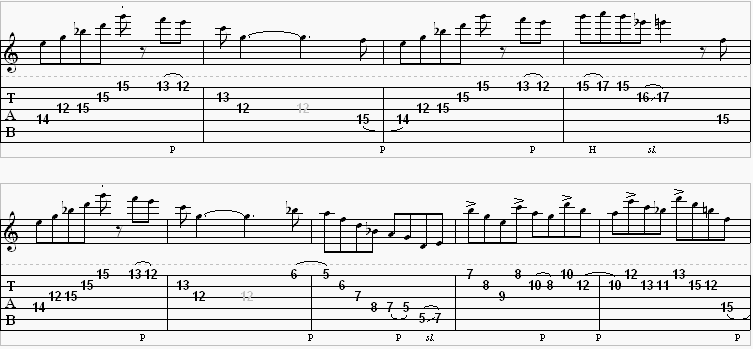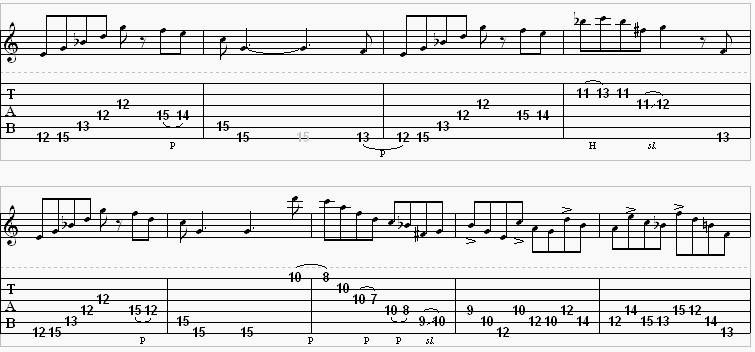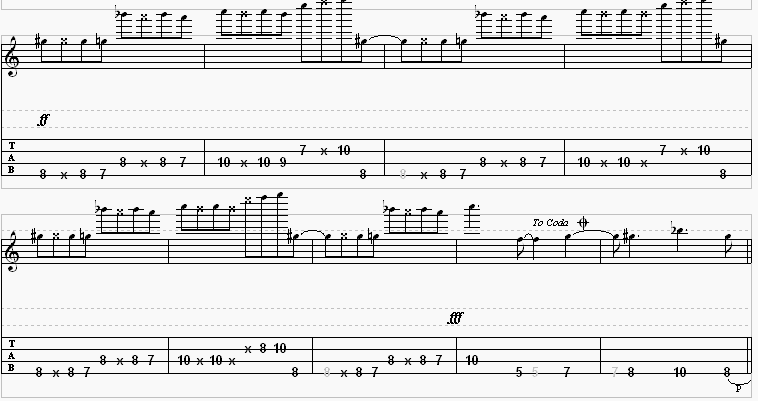Difficulty: Intermediate
Composer – Anderson
Where to find this song – Fragile track # 6
Release Date – January 1972
The Bio:
They were the longest lasting and the most successful of the ’70s rock groups. Yes proved one of the lingering success stories from that musical genre. The band, founded in 1968, hit the generation gap with its audience and the departure of its most visible members at key points in their careers. Prior to signing their first contract with Atlantic, Yes opened for Cream’s farewell concert at the Royal Albert Hall in 1968 and then opened for Janis Joplin the following year. Former guitarist Steve Howe joined super-group, Asia in the early ‘80s.
Intro Riff
Ok. This riff will be pretty difficult to learn, but a challenge is always good, right? This riff will be broken down a little so that the parts aren’t quite so daunting to learn. The riff is full of pull-offs, hammer-ons, and slides. It has two guitar parts playing harmony and a bass guitar part. Here’s what they sound like together:
Guitar 1

The first measure bleeds into the second measure, if you notice, and the first and second measures are identical to the fifth and sixth measures.
Begin the first measure by placing your 3rd finger on the fourteenth fret on the “D” string. Then, use your 1st finger to play the twelfth fret on the “G” string. After that, use your 4th finger to play the fifteenth fret on the same string. At this point, allow your 4th finger to barre the fifteenth fret on the “G” string, the “B” string, and the “high E” string. Play according to the tablature, and then use your 2nd finger to play the thirteenth fret on the “high E” string. Pull-off as shown in the definitions above to the twelfth fret on the same string with your 1st finger. Remember, the second measure comes in directly after the first measure, so next just use your 1st finger for the twelfth fret on the “G” string, and your 2nd finger for the thirteenth fret on the “B” string. At the end of this measure, you are asked to pull-off again from the fifteenth fret on the “D” string to the fourteenth fret on the same string. Do this by using your 4th finger for the fifteenth fret, and your 3rd finger on the pull-off on the fourteenth fret to lead into the third measure.
Notice that the third measure starts out identical to the very beginning of the first measure. Play the entire third measure just as you did in the first measure.
Begin the fourth measure by using your 1st finger for the fifteenth fret on the “high E” string. Hammer-on as directed in the definitions above to the seventeenth fret with your 3rd or 4th finger, whichever is most comfortable. Next, simply let off the seventeenth fret and play the fifteenth fret again on the same string. Use your 2nd finger for the next part. It will be on the sixteenth fret on the “B” string, and you will slide to the seventeenth fret on the same string. End the measure by playing the fifteenth fret on the “D” string with any finger, but it is best to use your 4th finger, because that is what you did in the end of the second measure, and that may help remember what you are doing.
At the end of the sixth measure, ( the fifth and beginning of the sixth measure was already explained in the first and second measures), you can see that you should probably use your 2nd finger on the sixth fret on the “high E” string, because you will pull-off to the fifth fret on the same string. Do that, and then use your 2nd finger for the sixth fret on the “B” string, then your 3rd finger for the seventh fret on the “G” string, and then your 4th finger for the eighth fret on the “D” string. Then all you have to do is use your 3rd finger for the seventh fret on the same string, and pull-off to the fifth fret with your 1st finger on the same string. End the seventh measure by sliding on the fifth fret on the “A” string to the seventh fret on the same string with your 1st finger.
For the eighth measure, begin by placing your 1st finger on the seventh fret on the “high E” string. Place your 2nd finger on the eighth fret on the “B” string. Last, place your 3rd finger on the ninth fret on the “G” string. Now, play that, starting with the seventh fret and going to the ninth fret. Here is where your fingers may get tangled up in knots!!! You will need to place your 1st finger on the eighth fret on the “high E” string and your 3rd finger on the tenth fret on the “B” string. Play the eighth fret, and then the tenth fret. Here is a pull-off. Do this by using your letting off with your 3rd finger, and at the same time, barre your 1st finger on the eighth fret now of both the “high E” string and the “B” string. Repeat this one more time to transition into the last measure, but just do it on the tenth and twelfth frets.
Now that you have done that, it is time for the last measure on this part. Notice that you have just played the beginning of it from the last measure, so now look at the tablature where it shows the thirteenth fret on the “B” string. Use your 3rd finger for the thirteenth fret, and then your 1st finger for the eleventh fret on the same string. Next, use your 1st finger for the thirteenth fret on the “high E” string. Use your 3rd or 4th finger for the fifteenth fret on the “B” string, and then use your 1st finger for the twelfth fret on the same string. End the measure by pulling-off on the fifteenth fret on the “D” string with your 4th finger. That should transition you right back into the first measure.
Guitar 2

These measures are also difficult. Begin with your 1st finger on the twelfth fret on the “low E” string. Use your 4th finger for the fifteenth fret on the same string. Next, use your 3rd finger to play the thirteenth fret on the “A” string, and then use your 1st finger to barre the twelfth frets on the “D” string and the “G” string. Keeping your 1st finger where it is, pull-off on the fifteenth fret to the fourteenth with your 3rd finger on the “D” string to end the measure.
The second measure is about the easiest measure in this whole lesson. Barre your 1st finger on the fifteenth frets on the “low E” string and the “A” string, and play accordingly. End this measure by using your 2nd finger to play the thirteenth fret on the “low E” string, and pull-off to the twelfth fret with your
1st finger.
The third measure bleeds from the second measure. After you have pulled-off from the twelfth fret with your 1st finger, do exactly what you did in the first measure of this guitar part to play this measure. Just don’t pull-off. Play it as you strike every note.
For the fourth measure, use your 1st finger on the eleventh fret on the “B” string. Hammer-on to the thirteenth fret with your 3rd finger on the same string, and then let off of the thirteenth fret and play the eleventh again. Next, just slide with your 1st finger from the eleventh fret on the “G” string to the twelfth fret on the same string. End the measure by using your 2nd finger on the “low E” string on the thirteenth fret. That will transition you to the
next part of the next measure, which is identical to the first measure. NOTE: There is a difference at the end of the fifth measure that is not like the first measure. You will play the twelfth fret instead of the fourteenth. You should be able to play it the same way though, even into the sixth measure.
At the end of the sixth measure, you will need to use your 3rd finger on the tenth fret on the “high E” string. Pull-off to the eighth fret on the same string with your 1st finger. Next, you will barring off and on at the tenth fret of the “B” string, the “G” string, and the “D” string. Watch closely on the tablature. Barre the tenth frets on those strings with your 3rd or 4th finger, whichever feels more comfortable. When you will pull-off on ALL of the pull-offs in this measure, you will need to use your 1st finger to play the seventh and eighth frets when they come around. After you have pulled-off, use your 1st finger to slide from the ninth fret on the “A” string to the tenth fret to end the measure.
For the eighth measure, use your 1st finger for the ninth measure on the “D” string. Use your 2nd finger for the tenth measure on the “A” string, and use your 3rd finger for the twelfth fret on the “low E” string. Play in the order of the tablature, and then move your 1st finger to the tenth fret on the “D” string. Place your 3rd finger on the twelfth fret on the “A” string. Now, just use your 1st finger for the tenth fret on the “A” string, and your 3rd finger for the twelfth fret on the “D” string. Notice that you just inverted the same chord. End this measure by using your 4th finger for the fourteenth fret on the “A” string.
For the last measure, use your 1st finger for the twelfth fret on the “A” string, and your 3rd finger for the fourteenth fret on “D” string. Then, you will need to use your 4th finger for the fifteenth fret on the “A” string. Use your 1st finger to play the thirteenth fret on the same string. Do the same thing next, but just do it on the “D” string, and extend it to the twelfth fret instead of the thirteenth fret. Next, place your 3rd finger on the fourteenth fret on the “A” string, and then your 2nd finger on the thirteenth fret on the “low E” string. YOU ARE FINISHED!
Bass

Mute – The word mute comes into play quite often. The word is a little misleading. When you mute a string, its not that you aren’t allowing it to play, like when you hit mute on your television or cd player. What it actually means is that you aren’t allowing an actual NOTE to be played. Do this by barely touching the string, but playing it anyway. It provides an excellent way of keeping time in a song. Bass guitars do this quite often.
Measures one, three, five, and seven are identical. Measures two, four, and six are mostly also. Just remember that on the fourth measure you won’t play the ninth fret on the “A” string. You will just mute it. On the sixth measure, you will be playing the eighth fret instead of the seventh, as well as no ninth fret on the “A” string.
To play the first measure, place your 3rd finger on the eighth fret on the “E” string. Play that once, and then mute the string. Play it again, and then use your 1st finger to play the seventh fret on the same string. Do the same exact thing on the “A” string to end the measure.
For the second measure, use your 3rd finger again to play the tenth fret on the “A” string. Mute it once, and then play it again. Play the ninth fret by using your 1st finger on the same string. To play the seventh fret on the “D” string, use your 1st finger. Mute it once, and then use your 3rd finger to play the tenth fret on the same string. End the measure by using your 2nd finger for the eighth fret on the “E” string.
For the eighth measure, place your 3rd finger on the tenth fret on the “A” string. Then, use your 1st finger for the fifth fret on the “E” string, and your 3rd finger for the seventh fret on the same string.
For the ninth measure, use your 2nd finger for the eighth fret on the “E” string. Use your 4th finger to play the tenth fret on the same string, and then end the measure by using your 2nd finger again for the eighth fret on the same string. That will transition you back to practicing the first measure again.
Riff Resources
Complete Transcription To “Long Distance Runaround” (PDF)
Complete Transcription To “Long Distance Runaround” (Power Tab)